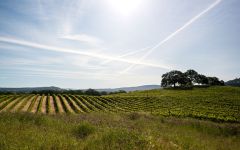Hall Kathryn Hall Cabernet Sauvignon (1.5 Liter Magnum) 2016
-
Robert
Parker -
Wilfred
Wong -
Wine
Spectator -
Jeb
Dunnuck -
Wine
Enthusiast



Product Details
Your Rating
Somm Note
Winemaker Notes
The 2016 Kathryn Hall is deep ruby in color with enticing aromas of cassis, violets, cacao, anise and black tea. This powerful vintage sets the stage for a full-bodied Cabernet Sauvignon with layered notes of dark plum, ripe blackberry, anise, pine needle and violet. The firm tannins are well integrated and provide a structured backbone to this opulent wine.
Blend: 90% Cabernet Sauvignon, 10% Merlot
Professional Ratings
-
Robert Parker's Wine Advocate
Deep garnet-purple colored, the 2016 Cabernet Sauvignon Kathryn Hall sashays out of the glass with beguiling notions of warm black and red currants, fresh blackberries, black raspberries and boysenberries with touches of rose hip tea, forest floor, pencil shavings and violets. Full-bodied with a taut foundation of firm, fine-grained tannins and bags of freshness, it has layer upon layer of perfumed black and red fruits, finishing long and fragrant.
-
Wilfred Wong of Wine.com
COMMENTARY: The Kathryn Hall Cabernet Sauvignons have climbed to the top of the mountain amongst the ultra-premium reds from the Napa Valley. The 2015 vintage is another standout wine. Its lively and jubilant aromas and flavors of red and black fruits, with a streak of minerality, should pair it superbly with a rosemary-infused oven-baked Porchetta. (Tasted: August 28, 2019, San Francisco, CA)
-
Wine Spectator
A beauty, with creamed plum, braised fig and melted black licorice notes that are long and deep, gliding through effortlessly and ending with a swath of espresso, loam and smoldering tobacco details. Hard to resist now, but will cruise in the cellar. Best from 2021 through 2035.
-
Jeb Dunnuck
Loads of blue fruits, kirsch liqueur, crushed violets, spring flowers, and orange blossom notes emerge from the 2016 Cabernet Sauvignon Kathryn Hall. This exotic, sexy 2016 has a light, elegant texture, nicely integrated acidity, ultra-fine tannins, and a great finish. It's another wine that blends power and elegance beautifully. Drink bottles over the coming 20-25 years.
-
Wine Enthusiast
Perfumed in violet and lavender, this rich, lush wine has 10% Merlot and is made from several vineyards, including the producer’s stellar Sacrashe. Lengths of red cherry, clove and earthy herbaceouness combine well around plush, opulent layers of tannin and toasted oak.
Other Vintages
2019-
Wilfred
Wong -
Jeb
Dunnuck -
Wine
Spectator -
Robert
Parker
-
Robert
Parker -
Jeb
Dunnuck -
Wine
Spectator -
Wilfred
Wong
-
Robert
Parker -
Wine
Spectator
-
Wilfred
Wong -
Jeb
Dunnuck -
Robert
Parker
-
Jeb
Dunnuck -
Robert
Parker -
Wine
Spectator
-
Robert
Parker -
Wine
Spectator
-
Robert
Parker -
Wine
Enthusiast -
Wine
Spectator
-
Wine
Spectator -
Wine
Enthusiast -
Robert
Parker
-
Robert
Parker -
Wine
Spectator
-
Wine
Spectator -
Robert
Parker
-
Wine
Spectator -
Wine
Enthusiast -
Robert
Parker
-
Wine
Enthusiast -
Robert
Parker
-
Wine
Spectator -
Wine
Enthusiast -
Robert
Parker
-
Robert
Parker -
Wine
Enthusiast
-
Wine
Enthusiast








Hall Wines is located in Napa Valley and employs organic small-vine viticulture, precision winemaking, wild-yeast fermentation and micro-block blending to fully extract the purity and quintessence of Napa Valley Cabernet Sauvignon. Their estate vineyards encompass more than 300 acres of classic Bordeaux varietals: Cabernet Sauvignon, Merlot and Sauvignon Blanc. The Halls have a strong respect for the environment and a commitment to cutting edge technology to yield the highest quality grapes. Through meticulous attention to detail in the vineyards, Hall wines are able to express the unique and diverse character of Napa Valley's soils and climate.

One of the most prestigious wines of the world capable of great power and grace, Napa Valley Cabernet is a leading force in the world of fine, famous, collectible red wine. Today the Napa Valley and Cabernet Sauvignon are so intrinsically linked that it is difficult to discuss one without the other. But it wasn’t until the 1970s that this marriage came to light; sudden international recognition rained upon Napa with the victory of the Stag’s Leap Wine Cellars 1973 Cabernet Sauvignon in the 1976 Judgement of Paris.
Cabernet Sauvignon undoubtedly dominates Napa Valley today, covering half of the land under vine, commanding the highest prices per ton and earning the most critical acclaim. Cabernet Sauvignon’s structure, acidity, capacity to thrive in multiple environs and ability to express nuances of vintage make it perfect for Napa Valley where incredible soil and geographical diversity are found and the climate is perfect for grape growing. Within the Napa Valley lie many smaller sub-AVAs that express specific characteristics based on situation, slope and soil—as a perfect example, Rutherford’s famous dust or Stags Leap District's tart cherry flavors.
